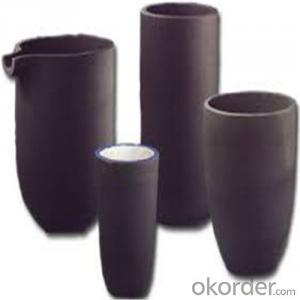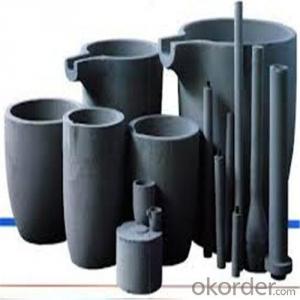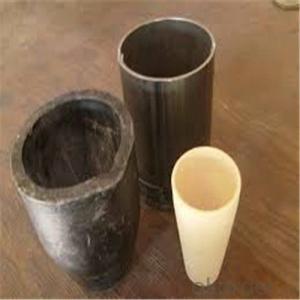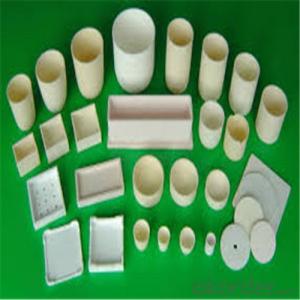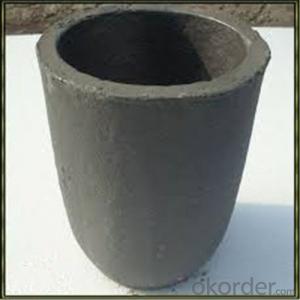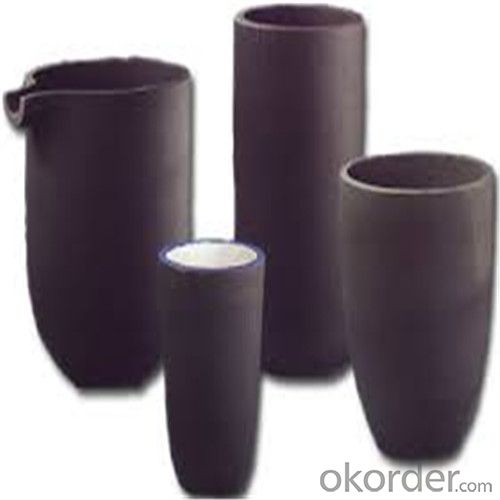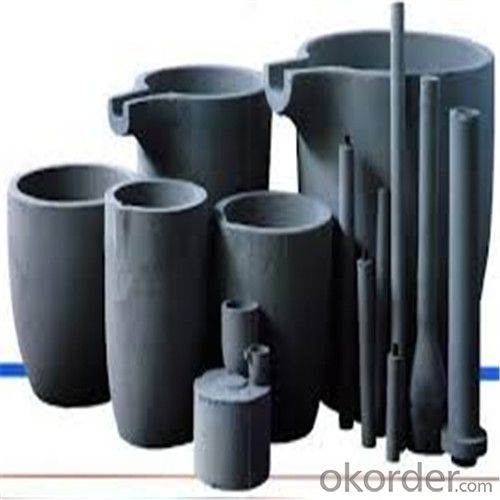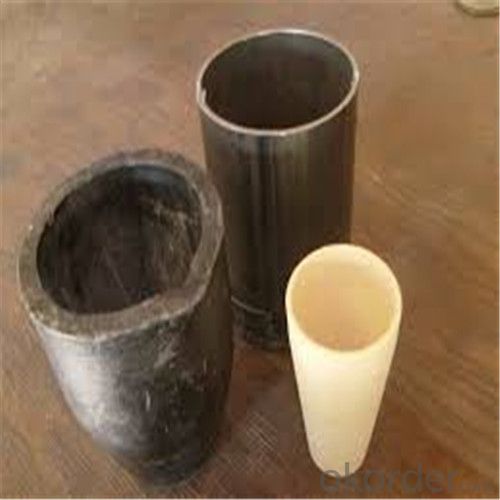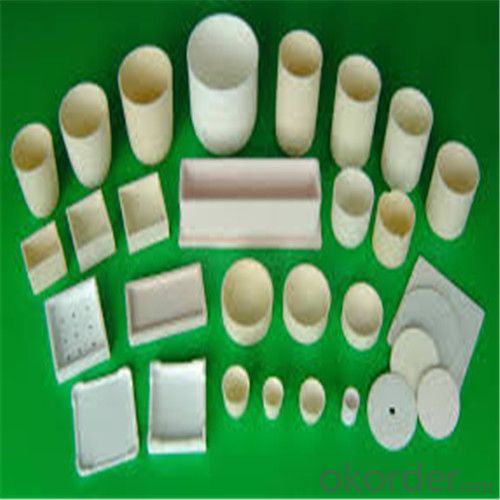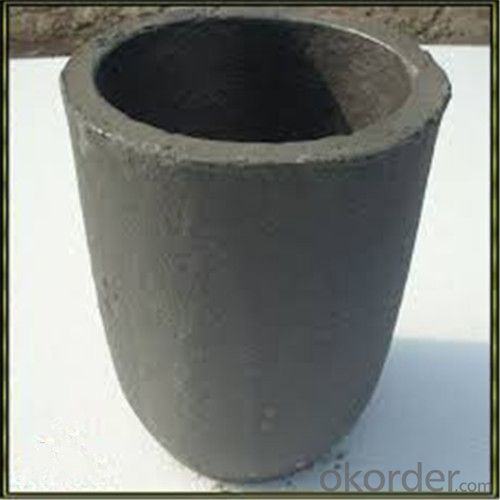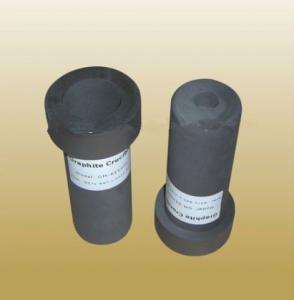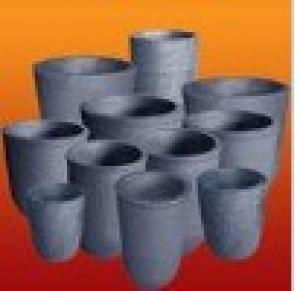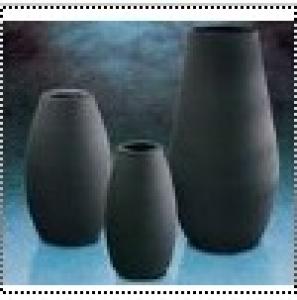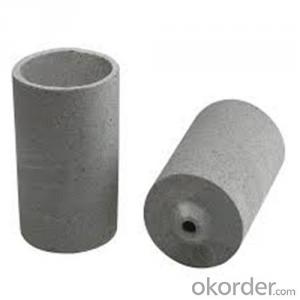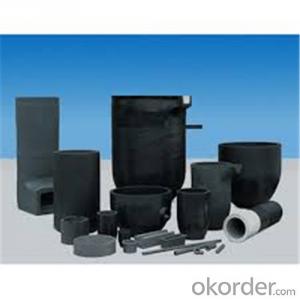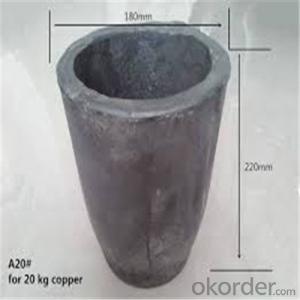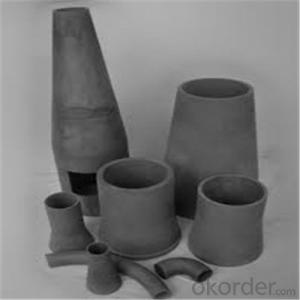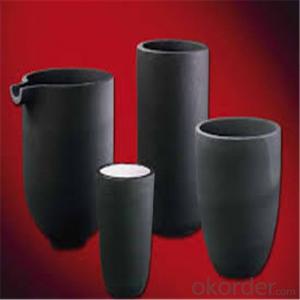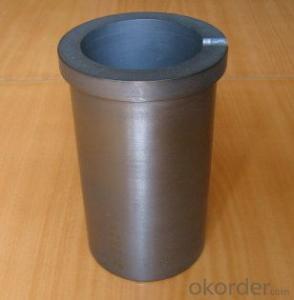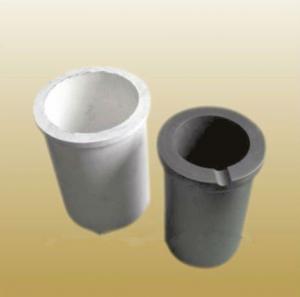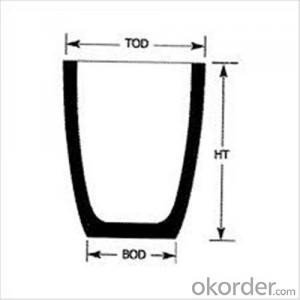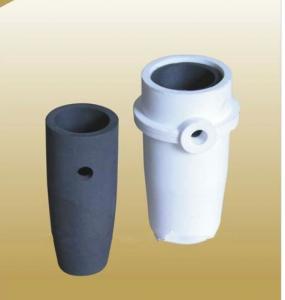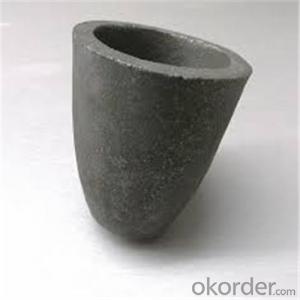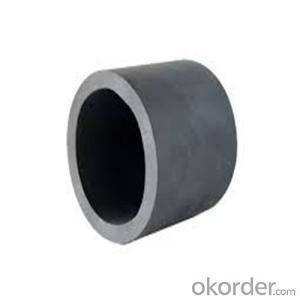Large Graphite Crucible for Melting Aluminium, Copper, and Brass
- Loading Port:
- Shanghai
- Payment Terms:
- TT OR LC
- Min Order Qty:
- 1 pc
- Supply Capability:
- 1000 pc/month
OKorder Service Pledge
OKorder Financial Service
You Might Also Like
Quick Details for SiC Graphite Crucibles
| Type: | High Strength, graphite crucible crucible | Application: | melting metal | Height: | as your requirements |
| Composition: | High Pure | Top Diameter: | 10-600mm | Bottom Diameter: | 10-1000mm |
| Place of Origin: | China (Mainland) | Brand Name: | Model Number: | ||
| Color: | Black grey | Si3N4%: | 5min | Fe2O3%: | 0.7max |
| C%: | 30-45 | Apparent porosity: | 30max | Refractoriness: | 1680 |
| Bulk Density: | 1.71min | Using life: | >5000 hours | MAX temperature: | 1600c |
Packaging & Delivery
| Packaging Details: | Seaworty packing or as per customer's detail requirement of graphite crucible. |
| Delivery Detail: | within 20-30 days after confirm order of graphite cru |
SiC Graphite Crucibles For Melting Aluminium And Copper, Brass
Product Description
Specifications for Graphite Silicon Carbide Crucible For Aluminum Melting :
1.Long working lifetime: its working lifetime is increased 3-5 times over normal clay-crucible due to the compact body formed under high pressure.
2.High thermal conductivity: high-density body and low apparent porosity greatly improve its heat conductivity.
3.New-style materials: new heat conduction material ensures faster heat conductivity and pollution-free product, reduces adherent slag.
4.Resistance to corrosion:better anti-corrosion than normal clay-crucible.
5.Resistance to oxidation: advanced process dramatically improves its oxidation resistance, which ensures persistent heat conductivity and long working lifetime.
6.High-strength: high-density body and logical structure make the product better compression property.
7.Eco-friendly: energy-efficient and pollution-free, not only ensure metal product purity, but also ensure sustainable development on environment.
8.Multi-function: Can be used in induction graphite crucible furnace
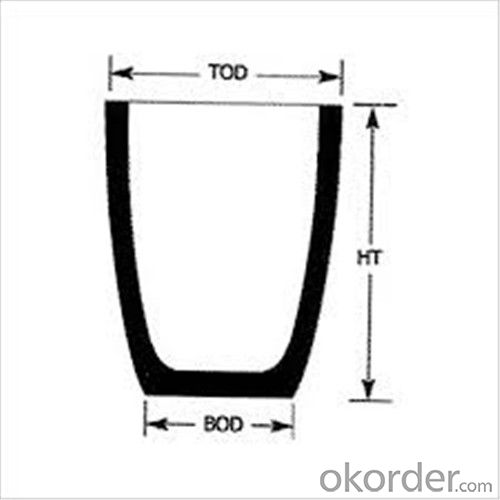
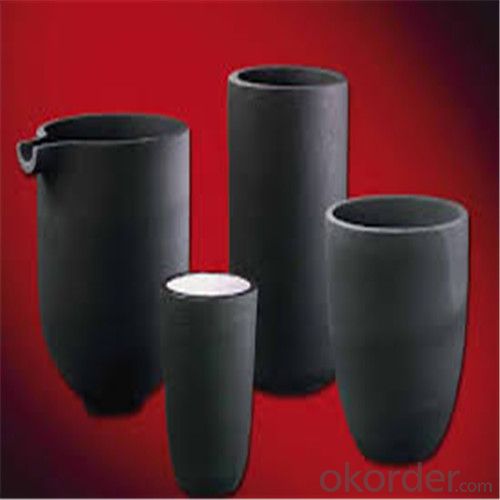
Physicochemical Properties
Type of Crucible | Type S | Type D |
Carbon Content/% | ≥38 | ≥45 |
Bulk Density/(g/cm3) | ≥1.70 | ≥1.85 |
Apparent Porosity/% | ≤29 | ≤21 |
Compression Strength/MPa | ≥20 | ≥25 |
Refractoriness/°C | ≥1400 | ≥1400 |
Type S: Clay graphite crucible
Type D: Isostatic pressing graphite crucible
Cited from CNS China National Standard of Graphite Crucible, which is solely drifted by TIANFU company.
Content Composition
C% | Sic% | AL2O3% | SIO2% |
45%-50% | 20%-30% | 10%-12% | 15-25% |
- Q: What is the white product in the crucible?
- Reacts with oxygen in the air to produce a white Zinc Oxide, producing white smoke, which does not melt into brass liquid, and the remaining copper in the crucible is also Zinc Oxide, so the phenomenon that you describe
- Q: What is the recommended fluxing method for a graphite crucible?
- The recommended fluxing method for a graphite crucible is to preheat the crucible to a temperature of around 600-800 degrees Celsius and then slowly add the desired flux material in small quantities, ensuring it evenly coats the inside surface of the crucible.
- Q: Can graphite crucibles be used for melting nickel?
- Indeed, nickel can be melted using graphite crucibles. These crucibles find widespread usage in high-temperature scenarios, such as the melting of different metals and alloys. Graphite boasts exceptional thermal conductivity and can endure extreme temperatures, rendering it an apt choice for melting nickel, which liquefies at approximately 1,455 degrees Celsius (2,651 degrees Fahrenheit). Furthermore, graphite crucibles exhibit commendable chemical resistance and do not undergo any reaction with nickel, thus facilitating a pristine and productive melting operation.
- Q: Can graphite crucibles be used for metal casting?
- Yes, graphite crucibles can be used for metal casting. Graphite is a common material used for crucibles in metal casting due to its high melting point and excellent thermal conductivity. It is particularly suitable for casting non-ferrous metals such as gold, silver, copper, and aluminum. Graphite crucibles can withstand high temperatures without cracking or deforming, making them ideal for melting and pouring molten metal. Additionally, graphite has low chemical reactivity, which prevents it from reacting with the metal being cast. This property ensures that the purity and quality of the final cast metal are maintained. However, it is important to note that graphite crucibles may not be suitable for casting certain metals with high melting points, such as steel, as they may not withstand the extreme temperatures required for melting these metals. In such cases, other materials like clay or ceramic crucibles may be more appropriate.
- Q: How do you ensure uniform heating of a graphite crucible?
- To ensure uniform heating of a graphite crucible, it is important to properly preheat the crucible before use. This can be done by placing the crucible in a furnace or heating device and gradually increasing the temperature to the desired level. Additionally, it is crucial to ensure that the heat source is evenly distributed around the crucible to prevent hotspots. This can be achieved by using a well-designed heating system that provides consistent heat distribution. Regularly rotating the crucible during the heating process can also help in achieving uniform heating.
- Q: Melting copper slag with a graphite crucible furnace can add any flux, in order to shorten the melting time and save fuel
- If you want to save fuel, it should be mainly due to the quality of the graphite crucible. The graphite content in the graphite crucible is higher
- Q: How does the reactivity of graphite affect the performance of a crucible?
- The reactivity of graphite directly affects the performance of a crucible. Graphite is known for its low reactivity and high thermal conductivity, making it an excellent material for crucibles. Its low reactivity means that it does not easily react with the substances being melted or heated inside the crucible, ensuring that the purity of the materials is maintained. This is particularly important in applications such as chemical analysis and metallurgy, where maintaining the integrity of the sample is crucial. Furthermore, the high thermal conductivity of graphite allows for efficient heat transfer, ensuring that the heat is evenly distributed throughout the crucible. This property helps in achieving uniform heating and melting of substances inside the crucible, leading to consistent and accurate results. In addition to its low reactivity and high thermal conductivity, graphite also has a high melting point, making it capable of withstanding high temperatures without deforming or breaking. This is essential for applications that involve high-temperature processes, such as melting metals or performing high-temperature chemical reactions. Overall, the reactivity of graphite plays a vital role in the performance of a crucible by ensuring the purity of the substances being heated, facilitating efficient heat transfer, and withstanding high temperatures.
- Q: Can graphite crucibles be used for carbon fiber production?
- Carbon fiber production can utilize graphite crucibles, which are often employed in high-temperature situations due to their exceptional thermal conductivity, high melting point, and chemical resistance. To create carbon fiber, graphite crucibles can be utilized to heat and liquefy the precursor materials like polyacrylonitrile (PAN) or pitch. These materials then undergo a series of steps to generate carbon fiber. Graphite, known for its high-temperature stability and lack of reactivity, serves as an ideal substance for maintaining the necessary conditions during the carbonization process. Furthermore, the smooth surface of graphite crucibles plays a significant role in achieving uniform heat distribution, an essential factor in ensuring the quality and consistency of carbon fiber production. As a result, graphite crucibles prove to be a suitable choice for the production of carbon fiber.
- Q: Is the jade pressed by the machine natural?
- The first is to make amorphous jade glass material. The reagent and reagent of sodium aluminum silicate and silicate containing colouring ions, formula according to jade composition content in a crucible into the mixing and grinding after the vessel, and then placed in a muffle furnace crucible is heated to 1100 degrees Celsius, and constant temperature cooling after a few hours, you will have to take the color of jade composition of amorphous glass material. The second is made of crystal jade glass. The amorphous glass will jade colored pieces to more than 125 meshes (i.e. particle size less than 0.125 mm), 600 kg / cm on the embedded prototype, heating prefabricated 14X15 (mm) cylinder or 14X6 (mm) of the wafer; then the preformed cylinder or wafer in high-purity graphite crucible. Bake in the oven at 140 degrees Celsius for 24 hours or more; and then the pressure chamber six crucible into a compressor, the compressor start six top closure, in the long time, current power, pressure relief, can get the crystal jade glass. Synthetic emerald glass by X ray powder diffraction analysis, infrared absorption spectrum analysis, chemical composition analysis, hardness measurement, relative density (specific gravity), determination of refractive index determination, fluorescence analysis, and the data are basically consistent with natural jade.
- Q: How to maintain the graphite crucible?
- Graphite crucible when in use must pay attention to whether there is a crack or graphite crucible itself is obvious, and must be regularly checked in graphite crucible after use, and must be a certain degree of cleaning of the graphite crucible in daily use
Send your message to us
Large Graphite Crucible for Melting Aluminium, Copper, and Brass
- Loading Port:
- Shanghai
- Payment Terms:
- TT OR LC
- Min Order Qty:
- 1 pc
- Supply Capability:
- 1000 pc/month
OKorder Service Pledge
OKorder Financial Service
Similar products
Hot products
Hot Searches
Related keywords
